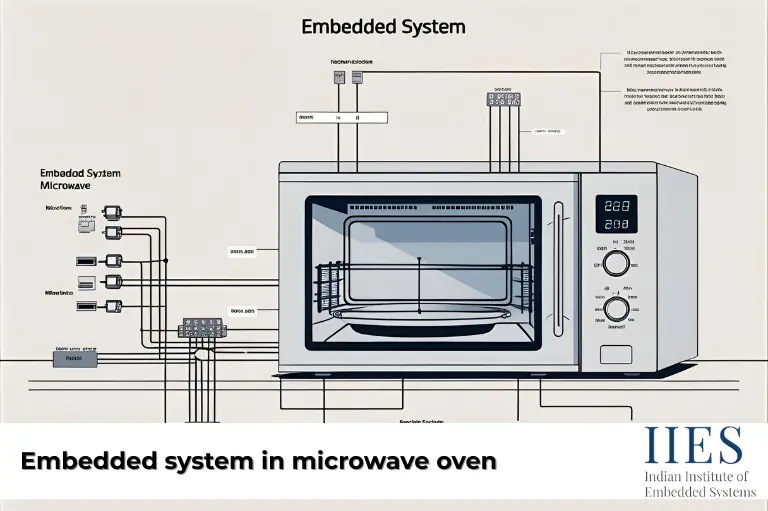
The embedded system in microwave oven is one of the best kitchen helpers for saving time. Whether reheating food or defrosting, it’s used every day. What makes it so efficient is its microcontroller units a tiny but powerful part that keeps cooking easy, safe, and reliable.
An embedded system in microwave ovens uses microcontrollers and sensors to manage heat, timing, and safety. It delivers accurate cooking, saves energy, and supports smart automation for modern kitchens.
An embedded system is a specialized computer built into a device to perform dedicated functions. In the case of a microwave oven, it manages tasks like:
This combination of hardware (like embedded microcontroller) and software (algorithms that regulate cooking) ensures that every meal is prepared quickly and consistently.
Every microwave depends on several key parts working together. These components handle everything from taking user input to controlling heat and ensuring food cooks safely.
At the core of the microwave’s embedded system is the microcontroller. Think of it as the brain that coordinates every function:
Without the microprocessor and embedded system, the microwave would just be a fancy metal box with no intelligence.
The user interface is what you see and interact with: the digital display, timer, and buttons. The microcontroller used in embedded system translates your input into cooking actions.
This simple interaction hides the fact that a lot of complex processing happens behind the scenes.
Sensors are what make your microwave smart and reliable. The microcontroller in embedded systems constantly monitors them to ensure safe operation.
Common ones include:
These sensors allow the microwave to prevent accidents, avoid food burning, and improve efficiency.
Every microwave has a clock—and it’s not just for showing the current time. This feature is a core part of any embedded system in microcontroller applications.
Accurate timing is one reason why microwaves are trusted for consistent results.
Power control is vital for precise cooking. Some modern appliances are designed as an embedded system with Arduino approach, offering flexible and efficient control.
The embedded system controls:
This regulation is what allows microwaves to cook both a bowl of soup and a bag of popcorn with equal precision.
Microwaves aren’t just fast—they’re smart. The embedded system brings efficiency by managing power, safety, and cooking modes in a way that saves both time and energy.
Modern microwaves come with cooking algorithms that adjust time and power for specific tasks—like reheating, grilling, or defrosting. These are possible only because the embedded system runs pre-set programs optimized for each food type.
From door interlocks to overheating cutoffs, the system ensures that microwaves are safe for daily use. This level of safety builds trustworthiness, a critical factor in consumer electronics.
Some microwaves now connect with IoT (Internet of Things) platforms:
This makes them more efficient in terms of convenience as well as performance.
With sustainability becoming a priority, manufacturers design embedded systems that optimize energy use. Smart power management ensures that microwaves only use as much electricity as needed—reducing costs and supporting eco-friendly living.
Microwave ovens have improved a lot over the years. From simple knob-based machines to today’s smart, connected devices, embedded systems have powered this transformation. The progress of MCU in embedded system technology has made them safer and smarter.
This evolution reflects how embedded systems have made microwaves smarter, safer, and more user-friendly with each generation.
Technology in microwaves is still evolving. With AI, advanced sensors, and IoT integration, the future promises even smarter and more personalized cooking experiences.
Looking ahead, we can expect:
The journey of embedded systems doesn’t stop at efficiency—it’s heading toward personalization and automation in everyday cooking.
| Component | Function | Benefit |
|---|---|---|
| Microcontroller | Controls cooking, sensors, and safety | Even and safe cooking |
| User Interface | Keypad, display, touch input | Easy user control |
| Sensors | Temperature, humidity, door, overheating | Precision and safety |
| Clock & Timing | Cycle management and countdown | Consistency and convenience |
| Power Regulation | Controls wattage and patterns | Energy efficiency |
| Connectivity | IoT and smart home integration | Smart, remote operation |
 Conclusion
ConclusionThe embedded system in microwave oven shows how specialized computing makes life easier. By managing time, power, safety, and connectivity, it keeps cooking fast, reliable, and energy-efficient. Each embedded microcontroller ensures that sensors and algorithms work in harmony.
It controls cooking time, temperature, and power so that food is heated evenly and safely.
It receives user inputs, processes them, and manages the oven’s functions like heating, light, and turntable.
Common sensors include door sensors, humidity sensors, and temperature sensors for safe operation.
It ensures the oven stops when the door is open and prevents overheating or electrical faults.
It manages auto-cook menus, defrost settings, child lock, and energy-saving modes in modern ovens.
No, without it the oven cannot process commands or manage heating, making it unsafe and unusable.
Indian Institute of Embedded Systems – IIES